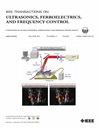3-D Transcranial Ultrasound Localization Microscopy Reveals Major Arteries in the Sheep Brain
IF 3
2区 工程技术
Q1 ACOUSTICS
IEEE transactions on ultrasonics, ferroelectrics, and frequency control
Pub Date : 2024-07-25
DOI:10.1109/TUFFC.2024.3432998
引用次数: 0
Abstract
Cerebral circulation ensures the proper functioning of the entire human body, and its interruption, i.e., stroke, leads to irreversible damage. However, tools for observing cerebral circulation are still lacking. Although MRI and computed tomography (CT) scans serve as conventional methods, their accessibility remains a challenge, prompting exploration into alternative, portable, and nonionizing imaging solutions like ultrasound with reduced costs. While ultrasound localization microscopy (ULM) displays potential in high-resolution vessel imaging, its 2-D constraints limit its emergency utility. This study delves into the feasibility of 3-D ULM with multiplexed probe for transcranial vessel imaging in sheep brains, emulating human skull characteristics. Three sheep underwent 3-D ULM imaging, compared with angiographic MRI, while skull characterization was conducted in vivo using ultrashort bone MRI sequences and ex vivo via micro-CT. The study showcased 3-D ULM’s ability to highlight vessels, down to the circle of Willis, yet within a confined 3-D field of view. Future enhancements in signal, aberration correction, and human trials hold promise for a portable, volumetric, transcranial ultrasound angiography system.三维经颅超声定位显微镜显示绵羊大脑中的主要动脉。
脑循环确保整个人体的正常运转,其中断(即中风)会导致不可逆转的损害。然而,目前仍缺乏观察脑循环的工具。虽然核磁共振成像和 CT 扫描是常规方法,但它们的可及性仍然是一个挑战,这促使人们探索其他便携式、非电离成像解决方案,如超声波,并降低成本。虽然超声定位显微镜(ULM)在高分辨率血管成像方面显示出潜力,但其二维局限性限制了其在紧急情况下的实用性。本研究探讨了三维超声定位显微镜与多路复用探头在绵羊大脑中进行经颅血管成像的可行性,模拟了人类头骨的特征。三只绵羊接受了三维超短波成像,并与血管造影 MRI 进行了比较,同时使用超短骨 MRI 序列进行了体内头骨特征描述,并通过显微 CT 进行了体外头骨特征描述。这项研究展示了三维超低功耗成像技术在有限的三维视场内突出显示血管的能力,甚至可以显示到威利斯环。未来在信号、像差校正和人体试验方面的改进将为便携式、容积式、经颅超声血管造影系统带来希望。
本文章由计算机程序翻译,如有差异,请以英文原文为准。
求助全文
约1分钟内获得全文
求助全文
来源期刊
CiteScore
7.70
自引率
16.70%
发文量
583
审稿时长
4.5 months
期刊介绍:
IEEE Transactions on Ultrasonics, Ferroelectrics and Frequency Control includes the theory, technology, materials, and applications relating to: (1) the generation, transmission, and detection of ultrasonic waves and related phenomena; (2) medical ultrasound, including hyperthermia, bioeffects, tissue characterization and imaging; (3) ferroelectric, piezoelectric, and piezomagnetic materials, including crystals, polycrystalline solids, films, polymers, and composites; (4) frequency control, timing and time distribution, including crystal oscillators and other means of classical frequency control, and atomic, molecular and laser frequency control standards. Areas of interest range from fundamental studies to the design and/or applications of devices and systems.

 求助内容:
求助内容: 应助结果提醒方式:
应助结果提醒方式:


